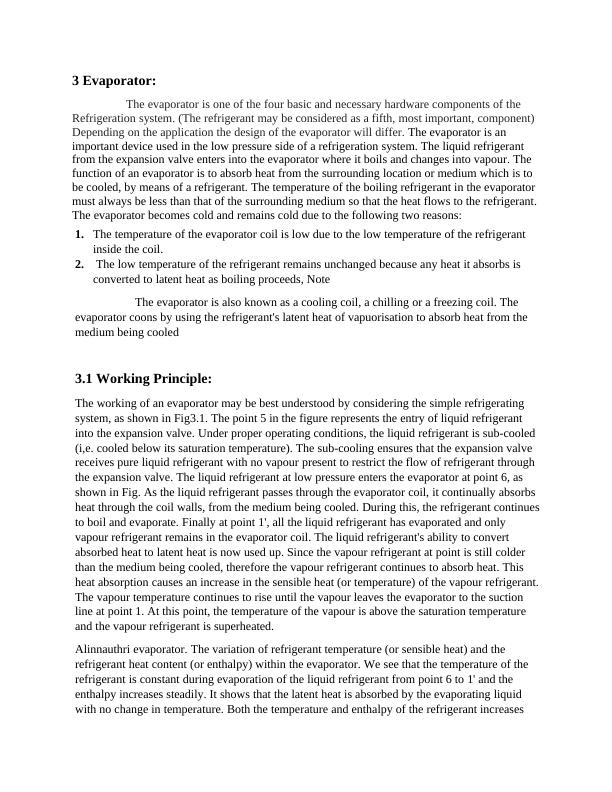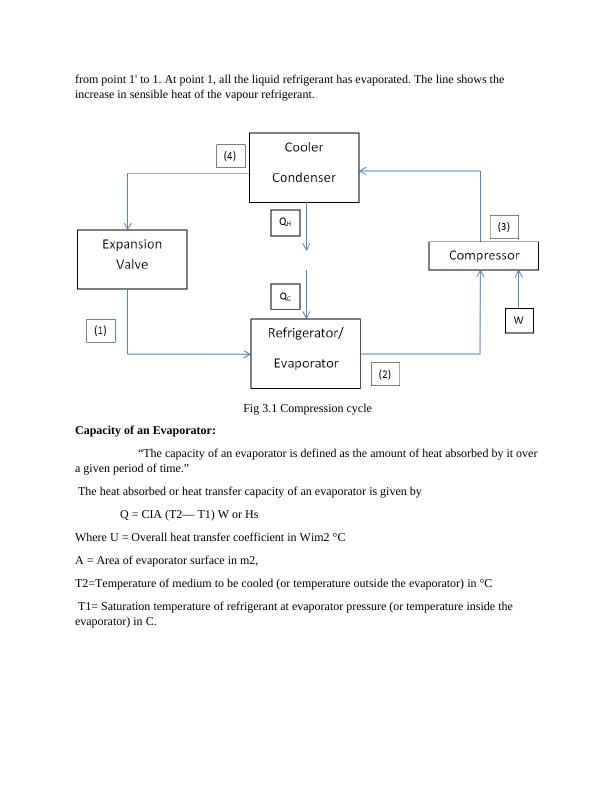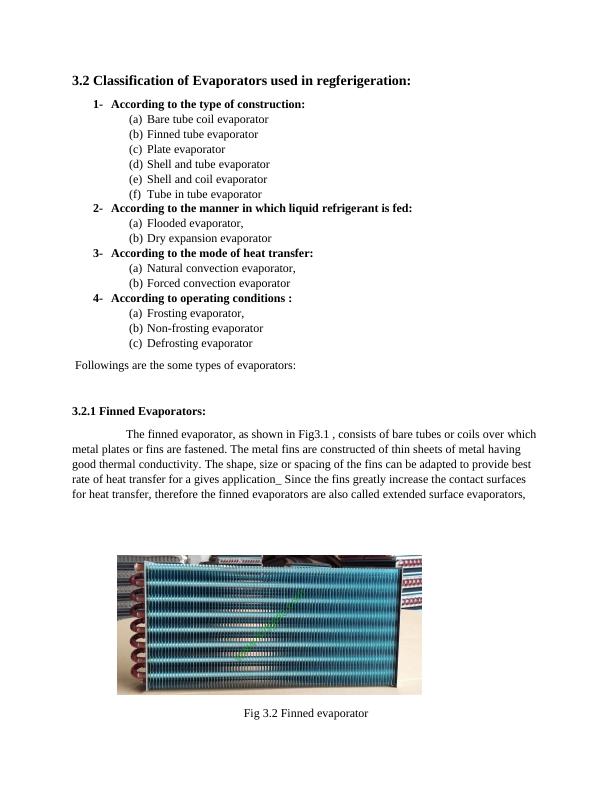(Solved) Function of an Evaporator
9 Pages2443 Words125 Views
Added on 2021-08-10
(Solved) Function of an Evaporator
Added on 2021-08-10
ShareRelated Documents
3 Evaporator:
The evaporator is one of the four basic and necessary hardware components of the
Refrigeration system. (The refrigerant may be considered as a fifth, most important, component)
Depending on the application the design of the evaporator will differ. The evaporator is an
important device used in the low pressure side of a refrigeration system. The liquid refrigerant
from the expansion valve enters into the evaporator where it boils and changes into vapour. The
function of an evaporator is to absorb heat from the surrounding location or medium which is to
be cooled, by means of a refrigerant. The temperature of the boiling refrigerant in the evaporator
must always be less than that of the surrounding medium so that the heat flows to the refrigerant.
The evaporator becomes cold and remains cold due to the following two reasons:
1. The temperature of the evaporator coil is low due to the low temperature of the refrigerant
inside the coil.
2. The low temperature of the refrigerant remains unchanged because any heat it absorbs is
converted to latent heat as boiling proceeds, Note
The evaporator is also known as a cooling coil, a chilling or a freezing coil. The
evaporator coons by using the refrigerant's latent heat of vapuorisation to absorb heat from the
medium being cooled
3.1 Working Principle:
The working of an evaporator may be best understood by considering the simple refrigerating
system, as shown in Fig3.1. The point 5 in the figure represents the entry of liquid refrigerant
into the expansion valve. Under proper operating conditions, the liquid refrigerant is sub-cooled
(i,e. cooled below its saturation temperature). The sub-cooling ensures that the expansion valve
receives pure liquid refrigerant with no vapour present to restrict the flow of refrigerant through
the expansion valve. The liquid refrigerant at low pressure enters the evaporator at point 6, as
shown in Fig. As the liquid refrigerant passes through the evaporator coil, it continually absorbs
heat through the coil walls, from the medium being cooled. During this, the refrigerant continues
to boil and evaporate. Finally at point 1', all the liquid refrigerant has evaporated and only
vapour refrigerant remains in the evaporator coil. The liquid refrigerant's ability to convert
absorbed heat to latent heat is now used up. Since the vapour refrigerant at point is still colder
than the medium being cooled, therefore the vapour refrigerant continues to absorb heat. This
heat absorption causes an increase in the sensible heat (or temperature) of the vapour refrigerant.
The vapour temperature continues to rise until the vapour leaves the evaporator to the suction
line at point 1. At this point, the temperature of the vapour is above the saturation temperature
and the vapour refrigerant is superheated.
Alinnauthri evaporator. The variation of refrigerant temperature (or sensible heat) and the
refrigerant heat content (or enthalpy) within the evaporator. We see that the temperature of the
refrigerant is constant during evaporation of the liquid refrigerant from point 6 to 1' and the
enthalpy increases steadily. It shows that the latent heat is absorbed by the evaporating liquid
with no change in temperature. Both the temperature and enthalpy of the refrigerant increases
The evaporator is one of the four basic and necessary hardware components of the
Refrigeration system. (The refrigerant may be considered as a fifth, most important, component)
Depending on the application the design of the evaporator will differ. The evaporator is an
important device used in the low pressure side of a refrigeration system. The liquid refrigerant
from the expansion valve enters into the evaporator where it boils and changes into vapour. The
function of an evaporator is to absorb heat from the surrounding location or medium which is to
be cooled, by means of a refrigerant. The temperature of the boiling refrigerant in the evaporator
must always be less than that of the surrounding medium so that the heat flows to the refrigerant.
The evaporator becomes cold and remains cold due to the following two reasons:
1. The temperature of the evaporator coil is low due to the low temperature of the refrigerant
inside the coil.
2. The low temperature of the refrigerant remains unchanged because any heat it absorbs is
converted to latent heat as boiling proceeds, Note
The evaporator is also known as a cooling coil, a chilling or a freezing coil. The
evaporator coons by using the refrigerant's latent heat of vapuorisation to absorb heat from the
medium being cooled
3.1 Working Principle:
The working of an evaporator may be best understood by considering the simple refrigerating
system, as shown in Fig3.1. The point 5 in the figure represents the entry of liquid refrigerant
into the expansion valve. Under proper operating conditions, the liquid refrigerant is sub-cooled
(i,e. cooled below its saturation temperature). The sub-cooling ensures that the expansion valve
receives pure liquid refrigerant with no vapour present to restrict the flow of refrigerant through
the expansion valve. The liquid refrigerant at low pressure enters the evaporator at point 6, as
shown in Fig. As the liquid refrigerant passes through the evaporator coil, it continually absorbs
heat through the coil walls, from the medium being cooled. During this, the refrigerant continues
to boil and evaporate. Finally at point 1', all the liquid refrigerant has evaporated and only
vapour refrigerant remains in the evaporator coil. The liquid refrigerant's ability to convert
absorbed heat to latent heat is now used up. Since the vapour refrigerant at point is still colder
than the medium being cooled, therefore the vapour refrigerant continues to absorb heat. This
heat absorption causes an increase in the sensible heat (or temperature) of the vapour refrigerant.
The vapour temperature continues to rise until the vapour leaves the evaporator to the suction
line at point 1. At this point, the temperature of the vapour is above the saturation temperature
and the vapour refrigerant is superheated.
Alinnauthri evaporator. The variation of refrigerant temperature (or sensible heat) and the
refrigerant heat content (or enthalpy) within the evaporator. We see that the temperature of the
refrigerant is constant during evaporation of the liquid refrigerant from point 6 to 1' and the
enthalpy increases steadily. It shows that the latent heat is absorbed by the evaporating liquid
with no change in temperature. Both the temperature and enthalpy of the refrigerant increases

from point 1' to 1. At point 1, all the liquid refrigerant has evaporated. The line shows the
increase in sensible heat of the vapour refrigerant.
Fig 3.1 Compression cycle
Capacity of an Evaporator:
“The capacity of an evaporator is defined as the amount of heat absorbed by it over
a given period of time.”
The heat absorbed or heat transfer capacity of an evaporator is given by
Q = CIA (T2— T1) W or Hs
Where U = Overall heat transfer coefficient in Wim2 °C
A = Area of evaporator surface in m2,
T2=Temperature of medium to be cooled (or temperature outside the evaporator) in °C
T1= Saturation temperature of refrigerant at evaporator pressure (or temperature inside the
evaporator) in C.
increase in sensible heat of the vapour refrigerant.
Fig 3.1 Compression cycle
Capacity of an Evaporator:
“The capacity of an evaporator is defined as the amount of heat absorbed by it over
a given period of time.”
The heat absorbed or heat transfer capacity of an evaporator is given by
Q = CIA (T2— T1) W or Hs
Where U = Overall heat transfer coefficient in Wim2 °C
A = Area of evaporator surface in m2,
T2=Temperature of medium to be cooled (or temperature outside the evaporator) in °C
T1= Saturation temperature of refrigerant at evaporator pressure (or temperature inside the
evaporator) in C.

3.2 Classification of Evaporators used in regferigeration:
1- According to the type of construction:
(a) Bare tube coil evaporator
(b) Finned tube evaporator
(c) Plate evaporator
(d) Shell and tube evaporator
(e) Shell and coil evaporator
(f) Tube in tube evaporator
2- According to the manner in which liquid refrigerant is fed:
(a) Flooded evaporator,
(b) Dry expansion evaporator
3- According to the mode of heat transfer:
(a) Natural convection evaporator,
(b) Forced convection evaporator
4- According to operating conditions :
(a) Frosting evaporator,
(b) Non-frosting evaporator
(c) Defrosting evaporator
Followings are the some types of evaporators:
3.2.1 Finned Evaporators:
The finned evaporator, as shown in Fig3.1 , consists of bare tubes or coils over which
metal plates or fins are fastened. The metal fins are constructed of thin sheets of metal having
good thermal conductivity. The shape, size or spacing of the fins can be adapted to provide best
rate of heat transfer for a gives application_ Since the fins greatly increase the contact surfaces
for heat transfer, therefore the finned evaporators are also called extended surface evaporators,
Fig 3.2 Finned evaporator
1- According to the type of construction:
(a) Bare tube coil evaporator
(b) Finned tube evaporator
(c) Plate evaporator
(d) Shell and tube evaporator
(e) Shell and coil evaporator
(f) Tube in tube evaporator
2- According to the manner in which liquid refrigerant is fed:
(a) Flooded evaporator,
(b) Dry expansion evaporator
3- According to the mode of heat transfer:
(a) Natural convection evaporator,
(b) Forced convection evaporator
4- According to operating conditions :
(a) Frosting evaporator,
(b) Non-frosting evaporator
(c) Defrosting evaporator
Followings are the some types of evaporators:
3.2.1 Finned Evaporators:
The finned evaporator, as shown in Fig3.1 , consists of bare tubes or coils over which
metal plates or fins are fastened. The metal fins are constructed of thin sheets of metal having
good thermal conductivity. The shape, size or spacing of the fins can be adapted to provide best
rate of heat transfer for a gives application_ Since the fins greatly increase the contact surfaces
for heat transfer, therefore the finned evaporators are also called extended surface evaporators,
Fig 3.2 Finned evaporator

End of preview
Want to access all the pages? Upload your documents or become a member.
Related Documents
Difference between Ideal and Real Vapour Cyclelg...
|8
|1323
|65
Vapour-compression Refrigeration - Lab Reportlg...
|11
|1996
|2095
Cooling and dehumidification of air PDFlg...
|9
|1110
|395
Overview of Kalina Cycle | Reportlg...
|5
|1276
|18
Effect of Temperature on Heat Pump Efficiency in Refrigerators, Air Conditioners, and Water Treatment Plantslg...
|8
|3997
|193
Thermodynamic Systems 12lg...
|13
|2664
|277
